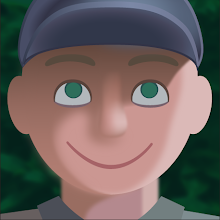(I'm redesigning, modeling, and rigging Gilbert Shelton's classic cartoon character, "Wonder Wart-Hog.")
color designs
This part went quickly, despite or owing to my ignorance of clothing design. The image shows the development process, from left to semi-final right. This just shows the colors of the costume. It doesn't take construction, texturing, and detailing into account.
The concept behind the design is to make him less silly and more intimidating, so I removed some of the more ridiculous features of the original: the 2-foot-long cape, the useless eye mask, the panties outside the pants, and the classic painted-on superhero outfit that serves no purpose but to obsess over muscle definition. The new outfit is less satirical and more practical. The character is still dull-witted, like the original, but didn't dress himself this time around.
dynamic clothing test
I developed this simple "crash* test" character (above image) to try out unfamiliar techniques, to help decide which direction to take the final character. Besides full-body inverse kinematics (FBIK), Maya's newish Muscle Creator, and Zbrush's impressive UV Master, I wanted to try dynamic soft body clothing. It quickly became apparent that dynamic clothing will not be practical for my final character. Above is the best image I could capture during my night of a thousand crashes*. (Note that my test character is outfitted in the classic Wonder Wart-hog colors. My final WW character will get the new costume.)
* i.e., memory-related software crashes
muscle test
For this test, I only built 3 muscles: biceps (arm), pectoralis (chest), and gastrocnemius (leg). Muscles deform a character's skin in a much more believable way, which is valuable for anatomically-correct characters, but probably unnecessary for cartoony characters.
wrinkles are sculpted, mapped, then test-rendered
(click to enlarge)
(click to enlarge)
I researched different faux-dynamics clothing systems, including driven blendshapes and wire deformers, but driven displacement maps seem the most practical given my hardware resources. It works like this: joint rotations control the intensity of various wrinkle maps. For example, an elbow bend will enable a displacement map of fabric bunching up at the elbow. Seen in the above image, the wrinkles are first sculpted, then transferred to a displacement map and test-rendered.
rigging tests video
Finally, the wrinkle sections are separated and assigned to different joints, using a layered texture and driven keys. The drawback with this technique is that, because they're created with displacement maps, the wrinkle animation cannot be hardware-previewed. It must be software-rendered first.
A similar technique will likely be used for the wrinkles in the face, and possibly the hands and boots.
next: final design, finally










No comments:
Post a Comment